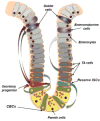Hierarchy and Plasticity in the Intestinal Stem Cell Compartment
- PMID: 28732600
- PMCID: PMC5612891
- DOI: 10.1016/j.tcb.2017.06.006
Hierarchy and Plasticity in the Intestinal Stem Cell Compartment
Abstract
Somatic stem cells maintain tissue homeostasis by organizing themselves in such a way that they can maintain proliferative output while simultaneously protecting themselves from DNA damage that may lead to oncogenic transformation. There is considerable debate about how such stem cell compartments are organized. Burgeoning evidence from the small intestine and colon provides support for a two-stem cell model involving an actively proliferating but injury-sensitive stem cell and a rare, injury-resistant pool of quiescent stem cells. Parallel with this evidence, recent studies have revealed considerable plasticity within the intestinal stem cell (ISC) compartment. We discuss the evidence for plasticity and hierarchy within the ISC compartment and how these properties govern tissue regeneration and contribute to oncogenic transformation leading to colorectal cancers.
Copyright © 2017 Elsevier Ltd. All rights reserved.
Figures



References
-
- Barker N, et al. Identification of stem cells in small intestine and colon by marker gene Lgr5. Nature. 2007;449:1003–1007. - PubMed
Publication types
MeSH terms
Grants and funding
LinkOut - more resources
Full Text Sources
Other Literature Sources
Medical

